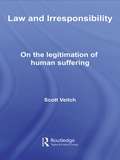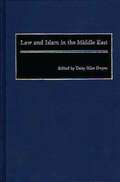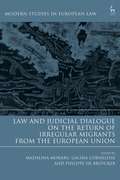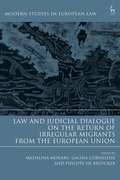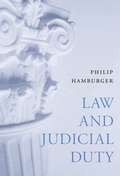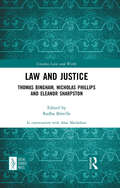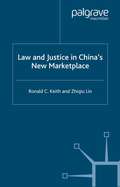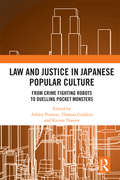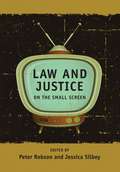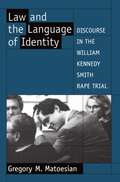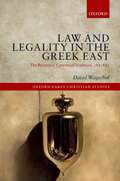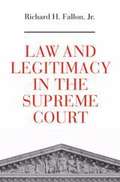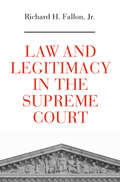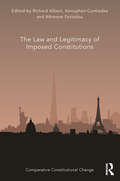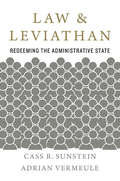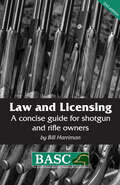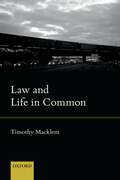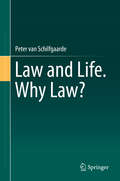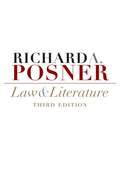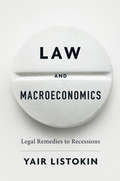- Table View
- List View
Law and Irresponsibility: On the Legitimation of Human Suffering
by Scott VeitchLaw is widely assumed to provide contemporary society with its most important means of organizing responsibility. Across a broad range of areas of social life – from the activities of states and citizens, to work, business and private relationships – it is understood that legal regulation plays a crucial role in defining and limiting responsibilities. But Law and Irresponsibility pursues the opposite view: it explores how law organizes irresponsibility. With a particular focus on large-scale harms – including extensive human rights violations, forms of colonialism, and environmental or nuclear devastation – this book analyzes the ways in which law legitimates human suffering by demonstrating how legal institutions operate as much to deflect responsibility for harms suffered as to acknowledge them. Drawing on a series of case studies, it shows not only how law facilitates the dispersal and disavowal of responsibility, but how it does so in consistent and patterned ways. Irresponsibility is organized, and its organization is traced here to the legal forms, and the social and political conditions, that sustain ‘our’ complicity in human suffering. This innovative and interdisciplinary book provides a radical challenge to conventional thinking about law and legal institutions. It will be of considerable interest to those working in law, political and legal theory, sociology and moral philosophy.
Law and Islam in the Middle East
by Daisy Hilse DwyerIslamic law is the epitome of Islamic thought, the most typical manifestation of the Islamic way of life, the core and kernel of Islam itself, asserts Joseph Schacht the internationally renowed Islamic law scholar. Indeed, the primary place of law in Islam as well as the preponderance of the legal over the theological in Muslim thinking has long been recognized by both Muslim jurisprudents and by Western legal scholars. At a time when Islamic fundamentalism is flourishing, the relation of religion in and to law-related behavior needs to be scrutinized. In its eight chapters, contributed by various experts in the field and with a cogent introduction by editor Daisy Hilse Dwyer that focuses on the sources of law, the reasons for its centrality in the Middle East, and personal status law, this volume considers Middle Eastern law as practiced by Muslims in a diversity of Middle Eastern nations. The dynamics of dispute settlement, the interaction of court personnel with litigants, the content of legislation, and the promulgation of public policies about law are detailed here as well as the power dynamics of law's interpersonal, intergroup, and international sides. Focusing on the specifics of contemporary politics and social life, the volume provides a baseline for understanding how, and the degree to which, the legal principles and the legal ethos elaborated in Islam centuries ago continue to provide a vital dynamic in legal behavior and thinking today.The first five chapters deal with the on-the-ground intricacies of personal status law. They detail the complex blend of options and constraints that Middle Easterners experience in confronting personal status issues and examine the different approaches to these issues by contrasting regional evironments and differentially empowered social groups. The last three chapters assess law in the public domain-an area in which the most striking recent applications of Islamic law have occurred. Law and Islam in the Middle East will be of particular value to international law experts, students of Islam, comparative law, and the Middle East, as well as practicing social scientists and others who seek a practical and philosophical understanding of how the spirit and letter of Islamic law constitute and reconstitute themselves with a fine-tuned responsiveness to a continuously changing nation and world.
Law and Judicial Dialogue on the Return of Irregular Migrants from the European Union (Modern Studies in European Law)
by Madalina Moraru, Galina Cornelisse and Philippe De BruyckerThis volume examines the implementation of the Return Directive from the perspective of judicial dialogue. While the role of judges has been widely addressed in European asylum law and EU law more generally, their role in EU return policy has hitherto remained under explored. This volume addresses the interaction and dialogue between domestic judiciaries and European courts in the implementation of European return policy. The book brings together leading authors from various backgrounds, including legal scholars, judges and practitioners. This allows the collection to offer theoretical and practical perspectives on important questions regarding the regulation of irregular migration in Europe, such as: what constitutes inadequate implementation of the Directive and under which conditions can judicial dialogue solve it? How can judges ensure that the right balance is struck between effective return procedures and fundamental rights? Why do we see different patterns of judicial dialogue in the Member States when it comes to particular questions of return policy, for example regarding the use of detention? These questions are more timely than ever given the shifting public discourse on immigration and the growing political backlash against immigration courts. This book will be essential reading for all scholars and practitioners in the fields of immigration law and policy, EU law and public law.
Law and Judicial Dialogue on the Return of Irregular Migrants from the European Union (Modern Studies in European Law)
This volume examines the implementation of the Return Directive from the perspective of judicial dialogue. While the role of judges has been widely addressed in European asylum law and EU law more generally, their role in EU return policy has hitherto remained under explored. This volume addresses the interaction and dialogue between domestic judiciaries and European courts in the implementation of European return policy. The book brings together leading authors from various backgrounds, including legal scholars, judges and practitioners. This allows the collection to offer theoretical and practical perspectives on important questions regarding the regulation of irregular migration in Europe, such as: what constitutes inadequate implementation of the Directive and under which conditions can judicial dialogue solve it? How can judges ensure that the right balance is struck between effective return procedures and fundamental rights? Why do we see different patterns of judicial dialogue in the Member States when it comes to particular questions of return policy, for example regarding the use of detention? These questions are more timely than ever given the shifting public discourse on immigration and the growing political backlash against immigration courts. This book will be essential reading for all scholars and practitioners in the fields of immigration law and policy, EU law and public law.
Law and Judicial Duty
by Philip HamburgerPhilip Hamburger’s Law and Judicial Duty traces the early history of what is today called “judicial review.” Working from previously unexplored evidence, Hamburger questions the very concept of judicial review. Although decisions holding statutes unconstitutional are these days considered instances of a distinct judicial power of review, Hamburger shows that they were once understood merely as instances of a broader judicial duty. The book’s focus on judicial duty overturns the familiar debate about judicial power. The book is therefore essential reading for anyone concerned about the proper role of the judiciary. Hamburger lays the foundation for his argument by explaining the common law ideals of law and judicial duty. He shows that the law of the land was understood to rest on the authority of the lawmaker and that what could not be discerned within the law of the land was not considered legally binding. He then shows that judges had a duty to decide in accord with the law of the land. These two ideals—law and judicial duty—together established and limited what judges could do. By reviving an understanding of these common law ideals, Law and Judicial Duty calls into question the modern assumption that judicial review is a power within the judges’ control. Indeed, the book shows that what is currently considered a distinct power of review was once understood as a matter of duty—the duty of judges to decide in accord with the law of the land. The book thereby challenges the very notion of judicial review. It shows that judges had authority to hold government acts unconstitutional, but that they enjoyed this power only to the extent it was required by their duty. In laying out the common law ideals, and in explaining judicial review as an aspect of judicial duty, Law and Judicial Duty reveals a very different paradigm of law and of judging than prevails today. The book, moreover, sheds new light on a host of misunderstood problems, including intent, manifest contradiction, the status of foreign and international law, the cases and controversies requirement, and the authority of judicial precedent.
Law and Justice: Thomas Bingham, Nicholas Phillips and Eleanor Sharpston (Creative Lives and Works)
by Alan MacfarlaneLaw and Justice: Thomas Bingham, Nicholas Phillips and Eleanor Sharpston is the first time a collection of interviews is being published as a book. These interviews have been conducted by one of England’s leading social anthropologists and historians, Professor Alan Macfarlane. Filmed over a period of several years, the three conversations in this volume are part of the series Creative Lives and Works. These transcriptions also form part of a larger set of interviews that cut across various disciplines, from the social sciences, the sciences and the performing and visual arts. The current volume is on three of Britain’s foremost lawyers and judges. Law and justice are an intrinsic part of any civilization, ancient or modern. English law traces its origins to medieval times, at times drawing on ancient legal systems prevalent in Roman and Anglo-Saxon laws. This tradition has had a huge influence across the world through export to the United States and throughout the nations of the former British Empire. The three conversations in this volume further reflect how interconnected the disciplines of history and law are. Thomas Bingham, Nicholas Phillips and Eleanor Sharpston give a wide sketch of the legal system through their own experiences and interpretations. They show how one of the single most important and unique features of British civilization works. The book will be of enormous value not just to those interested in the subject of Law and Justice but also History and Culture Studies as well as those with an interest in Legal Literature. Please note: This title is co-published with Social Science Press, New Delhi. Taylor & Francis does not sell or distribute the Hardback in India, Pakistan, Nepal, Bhutan, Bangladesh and Sri Lanka.
Law and Justice: Thomas Bingham, Nicholas Phillips and Eleanor Sharpston (Creative Lives and Works)
by Alan MacfarlaneLaw and Justice: Thomas Bingham, Nicholas Phillips and Eleanor Sharpston is the first time a collection of interviews is being published as a book. These interviews have been conducted by one of England’s leading social anthropologists and historians, Professor Alan Macfarlane. Filmed over a period of several years, the three conversations in this volume are part of the series Creative Lives and Works. These transcriptions also form part of a larger set of interviews that cut across various disciplines, from the social sciences, the sciences and the performing and visual arts. The current volume is on three of Britain’s foremost lawyers and judges. Law and justice are an intrinsic part of any civilization, ancient or modern. English law traces its origins to medieval times, at times drawing on ancient legal systems prevalent in Roman and Anglo-Saxon laws. This tradition has had a huge influence across the world through export to the United States and throughout the nations of the former British Empire. The three conversations in this volume further reflect how interconnected the disciplines of history and law are. Thomas Bingham, Nicholas Phillips and Eleanor Sharpston give a wide sketch of the legal system through their own experiences and interpretations. They show how one of the single most important and unique features of British civilization works. The book will be of enormous value not just to those interested in the subject of Law and Justice but also History and Culture Studies as well as those with an interest in Legal Literature. Please note: This title is co-published with Social Science Press, New Delhi. Taylor & Francis does not sell or distribute the Hardback in India, Pakistan, Nepal, Bhutan, Bangladesh and Sri Lanka.
Law and Justice in China's New Marketplace
by Ronald C. KeithLaw and Justice in China's New Marketplace provides the first comprehensive multidisciplinary analysis of the jurisprudence and related law underlying the contemporary Chinese transition to the 'socialist market economy'. New 'pluralized jurisprudence' has moved beyond Marxist class analysis to consider a new balance of values relating to economic efficiency and social justice in the marketplace, and yet the interior debates and perspectives concerning these values are virtually unknown in the Western scholarly literature. By analysing the changing Chinese approach in law to the adjustment of social interests in the context of profound economic change , Law and Justice in China's New Marketplace provides a unique reference tool. It outlines the new vocabulary of market jurisprudence and law and examines new legal thinking on rights protection with reference to widely ranging and often hot internal debate over human rights, property law and procedural or judicial justice.
Law and Justice in Japanese Popular Culture: From Crime Fighting Robots to Duelling Pocket Monsters
by Thomas Giddens Ashley Pearson Kieran TranterIn a world of globalised media, Japanese popular culture has become a signifi cant fountainhead for images, narrative, artefacts, and identity. From Pikachu, to instantly identifi able manga memes, to the darkness of adult anime, and the hyper- consumerism of product tie- ins, Japan has bequeathed to a globalised world a rich variety of ways to imagine, communicate, and interrogate tradition and change, the self, and the technological future. Within these foci, questions of law have often not been far from the surface: the crime and justice of Astro Boy; the property and contract of Pokémon; the ecological justice of Nausicaä; Shinto’s focus on order and balance; and the anxieties of origins in J- horror. This volume brings together a range of global scholars to refl ect on and critically engage with the place of law and justice in Japan’s popular cultural legacy. It explores not only the global impact of this legacy, but what the images, games, narratives, and artefacts that comprise it reveal about law, humanity, justice, and authority in the twenty-first century.
Law and Justice in Japanese Popular Culture: From Crime Fighting Robots to Duelling Pocket Monsters
by Thomas Giddens Ashley Pearson Kieran TranterIn a world of globalised media, Japanese popular culture has become a signifi cant fountainhead for images, narrative, artefacts, and identity. From Pikachu, to instantly identifi able manga memes, to the darkness of adult anime, and the hyper- consumerism of product tie- ins, Japan has bequeathed to a globalised world a rich variety of ways to imagine, communicate, and interrogate tradition and change, the self, and the technological future. Within these foci, questions of law have often not been far from the surface: the crime and justice of Astro Boy; the property and contract of Pokémon; the ecological justice of Nausicaä; Shinto’s focus on order and balance; and the anxieties of origins in J- horror. This volume brings together a range of global scholars to refl ect on and critically engage with the place of law and justice in Japan’s popular cultural legacy. It explores not only the global impact of this legacy, but what the images, games, narratives, and artefacts that comprise it reveal about law, humanity, justice, and authority in the twenty-first century.
Law and Justice on the Small Screen
by Peter Robson Jessica Silbey'Law and Justice on the Small Screen' is a wide-ranging collection of essays about law in and on television. In light of the book's innovative taxonomy of the field and its international reach, it will make a novel contribution to the scholarly literature about law and popular culture. Television shows from France, Canada, the United Kingdom, Germany, Spain and the United States are discussed. The essays are organised into three sections: (1) methodological questions regarding the analysis of law and popular culture on television; (2) a focus on genre studies within television programming (including a subsection on reality television), and (3) content analysis of individual television shows with attention to big-picture jurisprudential questions of law's efficacy and the promise of justice. The book's content is organised to make it appropriate for undergraduate and graduate classes in the following areas: media studies, law and culture, socio-legal studies, comparative law, jurisprudence, the law of lawyering, alternative dispute resolution and criminal law. Individual chapters have been contributed by, among others: Taunya Banks, Paul Bergman, Lief Carter, Christine Corcos, Rebecca Johnson, Stefan Machura, Nancy Marder, Michael McCann, Kimberlianne Podlas and Susan Ross, with an Introduction by Peter Robson and Jessica Silbey.
Law And The Language Of Identity: Discourse In The William Kennedy Smith Rape Trial
by Gregory M. MatoesianIn this volume, Gregory Matoesian uses the notorious 1991 rape trial of William Kennedy Smith to provide an in-depth analysis of language use and its role in that specific trial as well as in the law in general. He draws on the fields of conversation analysis, ethnomethodology, linguistic anthropology and social theory to show how language practices shape--and are shaped by--culture and the law, particularly in the social construction of rape as a legal fact. This analysis examines linguistic strategies from both defense and prosecutorial viewpoints, and how they relate to issues of gender, sexual identity, and power.
Law And Legality In The Greek East: The Byzantine Canonical Tradition, 381-883 (Oxford Early Christian Studies)
by David WagschalByzantine church law remains terra incognita to most scholars in the western academy. In this work, David Wagschal provides a fresh examination of this neglected but fascinating world. Confronting the traditional narratives of decline and primitivism that have long discouraged study of the subject, Wagschal argues that a close reading of the central monuments of Byzantine canon law c. 381-883 reveals a much more sophisticated and coherent legal culture than is generally assumed. Engaging in innovative examinations of the physical shape and growth of the canonical corpus, the content of the canonical prologues, the discursive strategies of the canons, and the nature of the earliest forays into systematization, Wagschal invites his readers to reassess their own legal-cultural assumptions as he advances an innovative methodology for understanding this ancient law. Law and Legality in the Greek East explores topics such as compilation, jurisprudence, professionalization, definitions of law, the language of the canons, and the relationship between the civil and ecclesiastical laws. It challenges conventional assumptions about Byzantine law while suggesting many new avenues of research in both late antique and early medieval law, secular and ecclesiastical.
Law and Legitimacy in the Supreme Court
by Richard H. Fallon Jr.Why do self-proclaimed constitutional “originalists” so regularly reach decisions with a politically conservative valence? Do “living constitutionalists” claim a license to reach whatever results they prefer, without regard to the Constitution’s language and history? In confronting these questions, Richard H. Fallon reframes and ultimately transcends familiar debates about constitutional law, constitutional theory, and judicial legitimacy. Drawing from ideas in legal scholarship, philosophy, and political science, Fallon presents a theory of judicial legitimacy based on an ideal of good faith in constitutional argumentation. Good faith demands that the Justices base their decisions only on legal arguments that they genuinely believe to be valid and are prepared to apply to similar future cases. Originalists are correct about this much. But good faith does not forbid the Justices to refine and adjust their interpretive theories in response to the novel challenges that new cases present. Fallon argues that theories of constitutional interpretation should be works in progress, not rigid formulas laid down in advance of the unforeseeable challenges that life and experience generate. Law and Legitimacy in the Supreme Court offers theories of constitutional law and judicial legitimacy that accept many tenets of legal realism but reject its corrosive cynicism. Fallon’s account both illuminates current practice and prescribes urgently needed responses to a legitimacy crisis in which the Supreme Court is increasingly enmeshed.
Law and Legitimacy in the Supreme Court
by Richard H. Fallon Jr.Why do self-proclaimed constitutional “originalists” so regularly reach decisions with a politically conservative valence? Do “living constitutionalists” claim a license to reach whatever results they prefer, without regard to the Constitution’s language and history? In confronting these questions, Richard H. Fallon reframes and ultimately transcends familiar debates about constitutional law, constitutional theory, and judicial legitimacy. Drawing from ideas in legal scholarship, philosophy, and political science, Fallon presents a theory of judicial legitimacy based on an ideal of good faith in constitutional argumentation. Good faith demands that the Justices base their decisions only on legal arguments that they genuinely believe to be valid and are prepared to apply to similar future cases. Originalists are correct about this much. But good faith does not forbid the Justices to refine and adjust their interpretive theories in response to the novel challenges that new cases present. Fallon argues that theories of constitutional interpretation should be works in progress, not rigid formulas laid down in advance of the unforeseeable challenges that life and experience generate. Law and Legitimacy in the Supreme Court offers theories of constitutional law and judicial legitimacy that accept many tenets of legal realism but reject its corrosive cynicism. Fallon’s account both illuminates current practice and prescribes urgently needed responses to a legitimacy crisis in which the Supreme Court is increasingly enmeshed.
The Law and Legitimacy of Imposed Constitutions (Comparative Constitutional Change)
by Richard Albert Xenophon Contiades Alkmene FotiadouConstitutions are often seen as the product of the free will of a people exercising their constituent power. This, however, is not always the case, particularly when it comes to ‘imposed constitutions’. In recent years there has been renewed interest in the idea of imposition in constitutional design, but the literature does not yet provide a comprehensive resource to understand the meanings, causes and consequences of an imposed constitution. This volume examines the theoretical and practical questions emerging from what scholars have described as an imposed constitution. A diverse group of contributors interrogates the theory, forms and applications of imposed constitutions with the aim of refining our understanding of this variation on constitution-making. Divided into three parts, this book first considers the conceptualization of imposed constitutions, suggesting definitions, or corrections to the definition, of what exactly an imposed constitution is. The contributors then go on to explore the various ways in which constitutions are, and can be, imposed. The collection concludes by considering imposed constitutions that are currently in place in a number of polities worldwide, problematizing the consequences their imposition has caused. Cases are drawn from a broad range of countries with examples at both the national and supranational level. This book addresses some of the most important issues discussed in contemporary constitutional law: the relationship between constituent and constituted power, the source of constitutional legitimacy, the challenge of foreign and expert intervention and the role of comparative constitutional studies in constitution-making. The volume will be a valuable resource for those interested in the phenomenon of imposed constitutionalism as well as anyone interested in the current trends in the study of comparative constitutional law.
The Law and Legitimacy of Imposed Constitutions (Comparative Constitutional Change)
by Richard Albert Xenophon Contiades Alkmene FotiadouConstitutions are often seen as the product of the free will of a people exercising their constituent power. This, however, is not always the case, particularly when it comes to ‘imposed constitutions’. In recent years there has been renewed interest in the idea of imposition in constitutional design, but the literature does not yet provide a comprehensive resource to understand the meanings, causes and consequences of an imposed constitution. This volume examines the theoretical and practical questions emerging from what scholars have described as an imposed constitution. A diverse group of contributors interrogates the theory, forms and applications of imposed constitutions with the aim of refining our understanding of this variation on constitution-making. Divided into three parts, this book first considers the conceptualization of imposed constitutions, suggesting definitions, or corrections to the definition, of what exactly an imposed constitution is. The contributors then go on to explore the various ways in which constitutions are, and can be, imposed. The collection concludes by considering imposed constitutions that are currently in place in a number of polities worldwide, problematizing the consequences their imposition has caused. Cases are drawn from a broad range of countries with examples at both the national and supranational level. This book addresses some of the most important issues discussed in contemporary constitutional law: the relationship between constituent and constituted power, the source of constitutional legitimacy, the challenge of foreign and expert intervention and the role of comparative constitutional studies in constitution-making. The volume will be a valuable resource for those interested in the phenomenon of imposed constitutionalism as well as anyone interested in the current trends in the study of comparative constitutional law.
Law and Leviathan: Redeeming The Administrative State
by Cass R. Sunstein Adrian VermeuleFrom two legal luminaries, a highly original framework for restoring confidence in a government bureaucracy increasingly derided as “the deep state.”Is the modern administrative state illegitimate? Unconstitutional? Unaccountable? Dangerous? Intolerable? American public law has long been riven by a persistent, serious conflict, a kind of low-grade cold war, over these questions.Cass Sunstein and Adrian Vermeule argue that the administrative state can be redeemed, as long as public officials are constrained by what they call the morality of administrative law. Law and Leviathan elaborates a number of principles that underlie this moral regime. Officials who respect that morality never fail to make rules in the first place. They ensure transparency, so that people are made aware of the rules with which they must comply. They never abuse retroactivity, so that people can rely on current rules, which are not under constant threat of change. They make rules that are understandable and avoid issuing rules that contradict each other.These principles may seem simple, but they have a great deal of power. Already, without explicit enunciation, they limit the activities of administrative agencies every day. But we can aspire for better. In more robust form, these principles could address many of the concerns that have critics of the administrative state mourning what they see as the demise of the rule of law. The bureaucratic Leviathan may be an inescapable reality of complex modern democracies, but Sunstein and Vermeule show how we can at last make peace between those who accept its necessity and those who yearn for its downfall.
Law and Licensing: A Concise Guide for Shotgun and Rifle Owners
by Bill HarrimanEveryone who uses a cartridge firearm in Great Britain is subject to the provisions of the Firearms Act 1968 -1997, both in terms of what the law prohibits and also to what the licensing system requires from an individual. Here, BASC provides definitive information on how to stay within the law as well as outlining the qualified rights it confers upon shooters. In this practical guide, one of Britain’s leading experts on firearm law explains: • Offenses and penalties in the Acts - what you can and cannot do • The licensing system • How to apply for a certificate • The law relating to young people • Security precautions • The new medical involvement process Ignorance of the law is no excuse. Not knowing what the law provides could deprive you of your sport, damage to your wallet or even cost you your liberty. Armed with the information in this book, there should be no danger of any of these happening to you.
Law and Life in Common
by Timothy MacklemWe live in a moral world in which reasons come in different kinds as well as different weights, so that the claims of one reason upon us are often different from but no greater than the claims of some other reason. Yet law, in its self-presentation and in theoretical accounts of it, proceeds as if its rational pull was conclusive, as if there were no sensible alternative to compliance with its terms. In itself that should not be surprising: each of us often acts as if the reasons that animate us were morally determinative. Why should law operate in any other way? Yet we know that in fact reasons are usually not determinative of action, and while pretence to the contrary may not much matter in individual settings, it matters very much in the setting of the law. The ability of the law to build a life in common, of whatever kind, is dependent on its ability to function, most of the time at least, as if its claims were pre-eminent, rather than undefeated at best. If law is to succeed in its basic project of binding people to its aims, it must buttress its limited rational claims with arational appeals. It needs partners, not only in the prudential considerations that force gives rise to, but also in the beguilement that shared imaginings make possible. This book is an exploration of those partnerships, in principle and in their most important details.
Law and Life in Common
by Timothy MacklemWe live in a moral world in which reasons come in different kinds as well as different weights, so that the claims of one reason upon us are often different from but no greater than the claims of some other reason. Yet law, in its self-presentation and in theoretical accounts of it, proceeds as if its rational pull was conclusive, as if there were no sensible alternative to compliance with its terms. In itself that should not be surprising: each of us often acts as if the reasons that animate us were morally determinative. Why should law operate in any other way? Yet we know that in fact reasons are usually not determinative of action, and while pretence to the contrary may not much matter in individual settings, it matters very much in the setting of the law. The ability of the law to build a life in common, of whatever kind, is dependent on its ability to function, most of the time at least, as if its claims were pre-eminent, rather than undefeated at best. If law is to succeed in its basic project of binding people to its aims, it must buttress its limited rational claims with arational appeals. It needs partners, not only in the prudential considerations that force gives rise to, but also in the beguilement that shared imaginings make possible. This book is an exploration of those partnerships, in principle and in their most important details.
Law and Life. Why Law?
by Peter van SchilfgaardeThis book is based on the assumption that the world is governed by a widespread field of interconnected laws. In this field man-made laws – legal laws - have to coexist with the laws of nature, the laws of science and the laws of logic. They have to find their place in relation to a certain society. They have to relate to the demands of morality, ethics, custom and trust. They have to follow the laws of language. They have to deal with a variety of professional and esthetic rules. They have to defend their position between art and craft. Finally, and significantly, they have to cope with a host of different ideas about truth. This book approaches law as a human construct meant to strengthen society as it develops through the ages. Knowledge of the law – legal knowledge – is of doubtful value if it ignores the demands and ideals of society. The same goes for the thinking leading to legal knowledge.This book focuses on a basic concept. That concept is met if the legal thinking, leading to legal knowledge, reaches the level of an independent, law and society oriented, contemplative discipline. A discipline which is in that sense and to that extent in touch with - cherished or less cherished - parts of given law.
Law and Literature: Third Edition
by Richard A. PosnerHailed in its first edition as an “outstanding work, as stimulating as it is intellectually distinguished” (New York Times), Law and Literature has handily lived up to the Washington Post’s prediction that the book would “remain essential reading for many years to come.” This third edition, extensively revised and enlarged, is the only comprehensive book-length treatment of the field. It continues to emphasize the essential differences between law and literature, which are rooted in the different social functions of legal and literary texts. But it also explores areas of mutual illumination and expands its range to include new topics such as the cruel and unusual punishments clause of the Constitution, illegal immigration, surveillance, global warming and bioterrorism, and plagiarism. In this edition, literary works from classics by Homer, Shakespeare, Milton, Dostoevsky, Melville, Kafka, and Camus to contemporary fiction by Tom Wolfe, Margaret Atwood, John Grisham, and Joyce Carol Oates come under Richard Posner’s scrutiny, as does the film The Matrix. The book remains the most clear, acute account of the intersection of law and literature.
Law and Literature: The Irish Case
Law and Literature: The Irish Case is a collection of fascinating essays by literary and legal scholars which explore the intersections between law and literature in Ireland from the eighteenth century to the present day. Sharing a concern for the cultural life of law and the legal life of culture, the contributors shine a light on the ways in which the legal and the literary have spoken to each other, of each other, and, at times, for each other, on the island of Ireland in the last three centuries. Several of the chapters discuss how texts and writers have found their ways into the law’s chambers and contributed to the development of jurisprudence. The essays in the collection also reveal the juridical and jurisprudential forces that have shaped the production and reception of Irish literary culture, revealing the law’s popular reception and its extra-legal afterlives.List of contributors: Rebecca Anne Barr, Max Barrett, Noreen Doody, Katherine Ebury, Adam Gearey, Tom Hickey, James Kelly, Colum Kenny, David Kenny, Heather Laird, Julie Morrissy, Gearóid O'Flaherty, Virginie Roche-Tiengo, Barry Sheils.
Law and Macroeconomics: Legal Remedies to Recessions
by Yair ListokinAfter 2008, private-sector spending took a decade to recover. Yair Listokin thinks we can respond more quickly to the next meltdown by reviving and refashioning a policy approach, used in the New Deal, to harness law’s ability to function as a macroeconomic tool, stimulating or relieving demand as required under certain crisis conditions.
